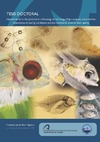Please use this identifier to cite or link to this item:
https://accedacris.ulpgc.es/jspui/handle/10553/4599
| Title: | Improvements in the production technology of red porgy (Pagrus pagrus) larvae and fry: importance of rearing conditions and diet nutritional value on their quality | Authors: | Roo, Javier | Director: | Izquierdo, Marisol | UNESCO Clasification: | 310502 Piscicultura | Keywords: | Bocinegro (Peces) | Issue Date: | 2009 | Abstract: | The main objective of this study was “to improve the production technology of red porgy
(Pagrus pagrus) larvae and fry”. Specific objectives were divided in two complementary and
consecutive phases; the first part was mainly based on a biological approach where specific
aspects of the first development stages of this species were described. Followed by a second part
where this knowledge was applied to develop a standard larval rearing protocol for commercial
production of this species.
In this sense, it was determined that red porgy larvae are visual feeders and hatch with an
incomplete and nonfunctional visual and digestive system. Along the third and fourth days posthatch,
major structural changes took place in the visual and digestive systems, with the definition
and pigmentation of the primary photoreceptors (cones) and mouth opening. At this moment, the
first digestive activity was detected in the midgut, which enables the larva to begin its exogenous
feeding. The second most important change in relation to visual system development was
detected around 20dah, when second photoreceptors nuclei appeared (rods), these structures
prepared larvae with a greater sensitivity and visual acuity, allowing them to prey under
restricted light conditions. These changes, agreed with the detection of the first gastric cells and
the progressive migration of the larvae, from shallow to depth water, suggesting changes in
feeding habits and culture conditions at this stage. El objetivo principal de este trabajo fue “la mejora de la tecnología de producción de larvas y alevines de bocinegro”. Los objetivos específicos se dividen en dos etapas consecutivas que se complementan, una primera parte del trabajo en la que se describen aspectos específicos sobre la biología y desarrollo de las primeras etapas de vida de esta especie, seguida de una segunda parte donde el conocimiento adquirido se aplicó al desarrollo de un protocolo estándar para la producción comercial de esta especie. En este sentido, se ha podido determinar que las larvas de bocinegro son predadores visuales, que eclosionan con un sistema visual y digestivo incompleto y no funcional. Entre el tercer y cuarto día post eclosión se producen los mayores cambios en el sistema visual, con la aparición de pigmentación en los fotoreceptores primarios (conos) y apertura de la boca, lo que capacita a la larva para comenzar su alimentación exógena. Igualmente en este momento se detecta la primera actividad digestiva a la altura del intestino medio. El segundo hito mas importante en el desarrollo del sistema visual se detecta en torno a los 20dpe, cuando aparecen los núcleos de los segundo fotoreceptores (bastones) que dotan a las larvas de una mayor agudeza y sensibilidad visual, permitiéndole predar en condiciones de una menor intensidad lumínica, estos cambios coinciden con la detección de las primeras células gástricas y la progresiva migración de las larvas desde las capas superficiales a mayor profundidad en la columna de agua, lo que permite determinar la necesidad de un cambio de alimentación y condiciones de cultivo en esta etapa. |
Department: | Departamento de Biología | Faculty: | Facultad de Ciencias del Mar | URI: | https://accedacris.ulpgc.es/handle/10553/4599 | ISBN: | 978-84-694-1124-7 | Rights: | by-nc-nd |
| Appears in Collections: | Tesis doctoral |
Page view(s)
64
checked on Jan 27, 2024
Download(s)
628
checked on Jan 27, 2024
Google ScholarTM
Check
Altmetric
Share
Export metadata
Items in accedaCRIS are protected by copyright, with all rights reserved, unless otherwise indicated.
